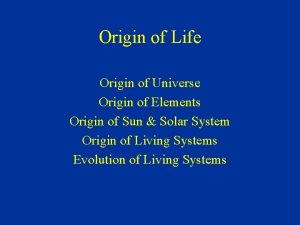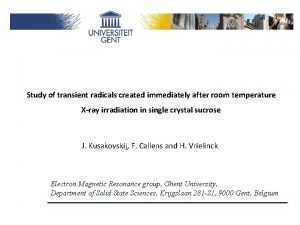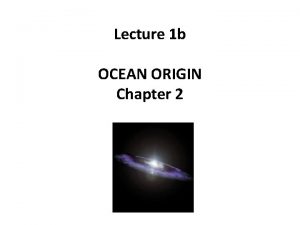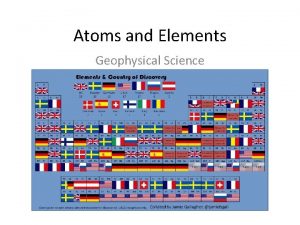Lecture 5 Origin of the Elements Immediately after













































- Slides: 45

Lecture 5 Origin of the Elements

Immediately after the Big Bang • Temperatures are so high that no atoms exist, only fundamental particles even smaller than neutrons and protons. There are no atoms or elements yet. • How does the universe then pass to this state, completely unfamiliar to us, to the collection of elements we find in the universe today?

Planetary Reality “Atoms are neither created nor destroyed” But where do the elements come from? How were they formed?

Single electron cloud (-) Proton (+)



The Chart of the Nuclides

The strong force is >100 times stronger than the electric force keeping the protons apart, but operates only over very small distances. If the protons get within one trillionth of a centimeter of each other, the strong force suddenly kicks in and sticks them together, with one very important proviso.

E= 2 MC If there is a loss of mass, then energy is released. If there is a gain in mass, energy needs to be added to make the reaction happen.

Important Concepts: The total mass of a nucleus depends on its energy as well as the number of protons and neutrons Nuclear Fusion happens as long as mass of the product nucleus is lower than the reacting nucelii AND, nuclear fusion requires the nucleii to “touch” so the strong force can operate, and this requires very high temperatures. A confined environment helps.

Mass of 4 hydrogen atoms: 6. 696 *10 -24 gm Mass of 1 helium atom: 6. 648 * 10 -24 gm Mass LOSS of. 048 *10 -24 gm Converting one gram of hydrogen to helium releases enough energy to boil 4. 4 million pounds of water BUT, temperatures of 10 million degrees are required for the protons to be forced together

During the Big Bang, the universe is rapidly expanding so temperatures decline very rapidly. There is a very short time window in which nuclear reactions can occur.

Only these first five of the elements are made during the Big Bang. Why? ? ? “Mass traps” at masses 5 and 8


Important Concepts: Stars form by contraction of massive clouds of gas, driven by gravity As the cloud contracts, all its energy is confined to a smaller volume and it heats up It keeps contracting and keeps heating up until some force operates to offset the gravitational contraction. That force is the heat generated by nuclear fusion. The bigger the star, the stronger the gravity, and the more heat is required to keep it from contracting

12 In easier units, the mass of C is defined as 12. 00, The mass of 6 protons and 6 neutrons is 12. 102 converts to 12. 00 LOSS OF MASS-- the reaction “burns” The mass of 56 Fe is 55. 935 28 the mass of two Si is 55. 954 converts to 55. 935 LOSS of MASS-- the reaction still “burns” But since the repulsive force is strong, these reactions require very high temperatures indeed.




Mass loss through fusion STOPS at 56 Fe. Heavier masses have more mass per nucleon So we face two puzzles: § How do stars make all the heavier elements? §How do the elements then get distributed from stellar interiors to the galaxy to make planets like Earth possible?

Fu sio Fusion exother m ic Stellar Nucleosynthesis V: nuclear binding energy 56 Fe H-burning is by far the most effective means of converting mass into energy! ne nd oth erm ic 1 H A • In principle, nuclear burning by fusion can continue only up to 56 Fe, the nucleus with the greatest binding energy per nucleon

What about masses out here? Or out here?

Important Concepts: The total mass of a nucleus depends on its energy as well as the number of protons and neutrons Nuclear Fusion cannot proceed beyond 56 Fe. For a given number of neutrons and protons, the lowest mass nucleus is the most stable. Neutrons and protons are convertible! The reaction: n p+ + e. Can go in both directions to obtain minimum mass. For mass 1, it proceeds to the right with a half life of 10. 3 minutes



What is the limit to atom size? ?

Conceptual understanding of radioactive decay and maximum size of atomic nucleii can come from the realization that: (1) protons repel each other; (2) neutrons left to themselves decay.

Solid black squares are radioactive isotopes with fairly long half lives

Multiply temperature by ~ 10 million to get temperature in degrees Kelvin.






Production of elements heavier than Fe by s-(slow) and r-(rapid) processes


What is the limit to atom size? ?




Is there concrete evidence for these processes? • How can stars be so hot for so long? • Super Nova explosions are observed • Calculations of relative element abundances correspond to observations, in detail • Technetium lines observed in supernova debris • Evidence for short-lived radionuclides in solar system materials


At the beginning… Formation of the elements Big Bang Our solar system forms at this time

Galaxies

Element Formation depends on position within a galaxy
 After me after me after me
After me after me after me If any man comes after me
If any man comes after me Where on a motorway would you find green reflective studs
Where on a motorway would you find green reflective studs 01:640:244 lecture notes - lecture 15: plat, idah, farad
01:640:244 lecture notes - lecture 15: plat, idah, farad According to walter pauk, 10 weeks after lecture
According to walter pauk, 10 weeks after lecture Example of direct speech and indirect speech
Example of direct speech and indirect speech If a laboratory fire erupts immediately
If a laboratory fire erupts immediately Personal eyeglasses provide as much protection as
Personal eyeglasses provide as much protection as Msha immediately reportable
Msha immediately reportable Hình ảnh bộ gõ cơ thể búng tay
Hình ảnh bộ gõ cơ thể búng tay Bổ thể
Bổ thể Tỉ lệ cơ thể trẻ em
Tỉ lệ cơ thể trẻ em Chó sói
Chó sói Chụp tư thế worms-breton
Chụp tư thế worms-breton Bài hát chúa yêu trần thế alleluia
Bài hát chúa yêu trần thế alleluia Môn thể thao bắt đầu bằng chữ đua
Môn thể thao bắt đầu bằng chữ đua Thế nào là hệ số cao nhất
Thế nào là hệ số cao nhất Các châu lục và đại dương trên thế giới
Các châu lục và đại dương trên thế giới Công thức tiính động năng
Công thức tiính động năng Trời xanh đây là của chúng ta thể thơ
Trời xanh đây là của chúng ta thể thơ Mật thư tọa độ 5x5
Mật thư tọa độ 5x5 Phép trừ bù
Phép trừ bù độ dài liên kết
độ dài liên kết Các châu lục và đại dương trên thế giới
Các châu lục và đại dương trên thế giới Thể thơ truyền thống
Thể thơ truyền thống Quá trình desamine hóa có thể tạo ra
Quá trình desamine hóa có thể tạo ra Một số thể thơ truyền thống
Một số thể thơ truyền thống Cái miệng nó xinh thế chỉ nói điều hay thôi
Cái miệng nó xinh thế chỉ nói điều hay thôi Vẽ hình chiếu vuông góc của vật thể sau
Vẽ hình chiếu vuông góc của vật thể sau Biện pháp chống mỏi cơ
Biện pháp chống mỏi cơ đặc điểm cơ thể của người tối cổ
đặc điểm cơ thể của người tối cổ Thế nào là giọng cùng tên? *
Thế nào là giọng cùng tên? * Vẽ hình chiếu đứng bằng cạnh của vật thể
Vẽ hình chiếu đứng bằng cạnh của vật thể Phối cảnh
Phối cảnh Thẻ vin
Thẻ vin đại từ thay thế
đại từ thay thế điện thế nghỉ
điện thế nghỉ Tư thế ngồi viết
Tư thế ngồi viết Diễn thế sinh thái là
Diễn thế sinh thái là Dạng đột biến một nhiễm là
Dạng đột biến một nhiễm là Bảng số nguyên tố lớn hơn 1000
Bảng số nguyên tố lớn hơn 1000 Tư thế ngồi viết
Tư thế ngồi viết Lời thề hippocrates
Lời thề hippocrates Thiếu nhi thế giới liên hoan
Thiếu nhi thế giới liên hoan ưu thế lai là gì
ưu thế lai là gì




































































